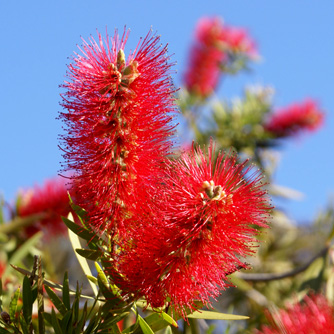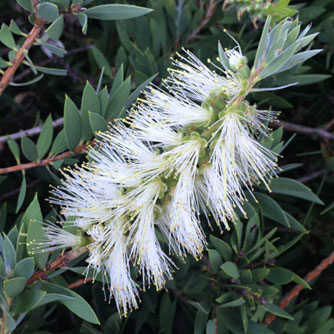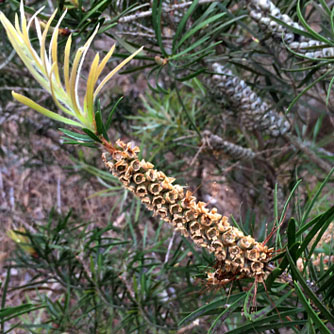Bottlebrush
BackBottlebrushes get their common name from their flowers which look like old fashioned bottle cleaners. Their botanical name is Callistemon and they belong to the Myrtaceae family (like eucalypts and lilly pillies).
Bottlebrushes are extremely hardy and long living plants which put on a brilliant floral display. Flowering is usually heaviest in Spring but many continue producing flowers through into Autumn. Originally flowers only came in red but are now available in cream, white, green, pink and mauve.
An added benefit is the flowers are nectar rich and attract pollinating insects (like bees) and nectar feeding birds such as honeyeaters and parrots.
Bottlebrushes are available in various sizes from small shrubs right up to trees. They are ideal for many uses such as feature plantings, screening, windbreaks, street trees and coastal plantings due to their salt tolerance.
How to Grow Bottlebrushes
Bottlebrushes are low maintenance plants and depending on the variety or species can cope with full sun, part shade, dry conditions, damp spots and light frost. They’ll also grow in sandy soils right through to heavy clay soils. Pretty versatile hey? Just select a plant which suits the spot you’re going to plant it in (as specified on the label).

The amazing bottlebrush flowers
Whilst they can handle damp soils not all are happy with really wet feet. If you’re planting into heavy clay first improve the drainage by applying gypsum and then raise the soil level by mounding up the garden bed.
Keep in mind that plants growing in shadier spots will usually produce fewer flowers.
Fertilising Bottlebrushes
Bottlebrushes aren’t particularly hungry plants and unlike some natives they’re also not phosphorus sensitive. This means you don’t have to be too worried about what you feed them. Organic fertilisers like manures, composts and pelletised products (check they are Certified Organic) are all good. Plants will be happy with a feed after the Spring flowering finishes and perhaps again in Autumn.
For young plants which you want to push along increase the fertilising to every 2-3 months (in accordance with the product label) plus give them a liquid feed of OCP eco-aminogro every 2-4 weeks. This will really get the plant pumping! If you want to be extra good add some OCP eco-seaweed into the mix to stimulate plant activity and help it cope with various stress factors.
Pruning Bottlebrushes
If left unpruned many bottlebrushes can end up looking a bit open and leggy. To avoid this give them a light prune in Spring after the main flowering flush finishes. Trim just behind the spent flower heads. This will encourage some dense new growth and of course more flowers.

The less common white bottlebrush
Pest & Disease Problems of Bottlebrushes
Bottlebrushes are not really troubled by many pests or diseases provided they are growing in conditions which suit that variety.
Scale may attack and need to be controlled with an organic insecticide.
Sometimes sooty mould develops but several sprays of OCP eco-oil will get things back on track.
The Callistemon sawfly larvae can also attack and skeletonise leaves. Prune off any damaged parts and infestations.
Our Best Bottlebrushes
There are so many to choose from but here are some tried and true favourites :
- Callistemon ‘Little John’ – grows 1m high x 1m wide with dark red flowers for most of the year
- Callistemon ‘Captain Cook’ – grows 1.2-2m high x 1.2-2m wide with red flowers for most of the year
- Callistemon ‘Hot Pink’ – grows 1.5-2m high x 1.5-2m wide with very bright pink flowers
- Callistemon ‘White Anzac’ – grows 1.5m high x 1.5m wide with white/cream flowers
- Callistemon ‘Purple Cloud’ – grows 2m high x 2m wide with dark red flowers for most of the year
- Callistemon ‘Endeavour’ – grows 2-3m high x 3m wide with brilliant bright red flowers
- Callistemon ’Hanna Ray’ – grows 4-5m high x 2-3m wide with red flowers

Prune off finished flower spikes to encourage compact growth


